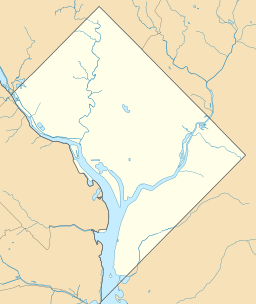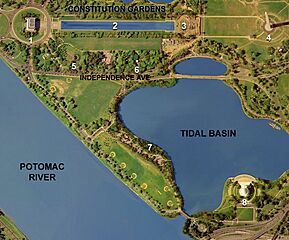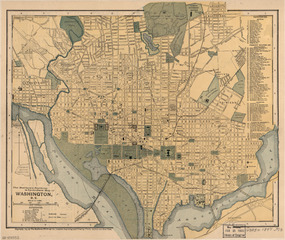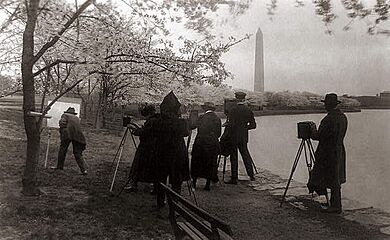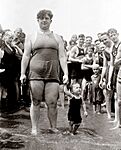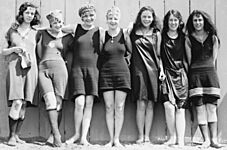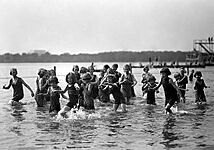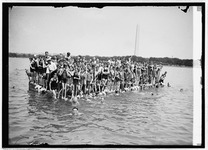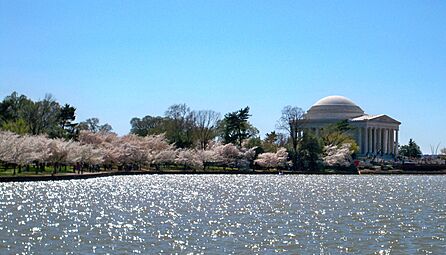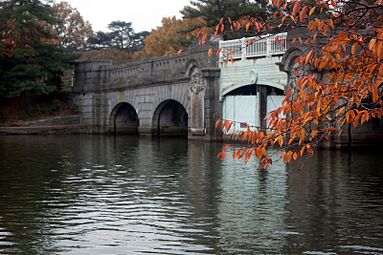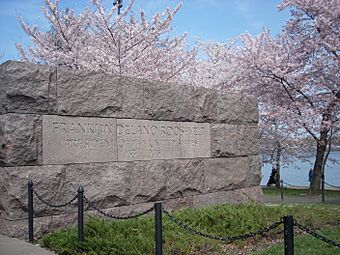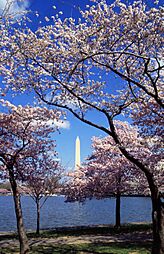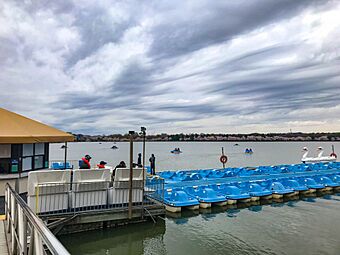Tidal Basin facts for kids
Quick facts for kids Tidal Basin |
|
|---|---|

The Tidal Basin (foreground), the Washington Monument (on left) and the Jefferson Memorial (on right), July 2016
|
|
| Location | West Potomac Park, Washington, D.C., U.S. |
| Coordinates | 38°53′03″N 77°02′21″W / 38.88417°N 77.03917°W |
| Type | Artificial |
| Primary inflows | Potomac River 38°52′49″N 77°02′25″W / 38.88028°N 77.04028°W |
| Primary outflows | Washington Channel 38°52′58″N 77°01′59″W / 38.88278°N 77.03306°W |
| Basin countries | United States |
| Surface area | 107 acres (0.43 km2) |
| Average depth | 10 feet (3.0 m) |
| Surface elevation | 3 feet (0.91 m) |
The Tidal Basin is a special man-made lake in Washington, D.C.. It sits between the Potomac River and the Washington Channel. This basin is part of West Potomac Park and is close to the National Mall.
It's a very important spot for the National Cherry Blossom Festival every spring. Many famous memorials are nearby, like the Jefferson Memorial, Martin Luther King Jr. Memorial, and Franklin Delano Roosevelt Memorial. The Washington Monument is also just to the north.
Contents
History of the Tidal Basin
The idea for the Tidal Basin came about in the 1870s. It was designed to be a beautiful landmark. It also helped to clean out the Washington Channel. This channel is a harbor separated from the Potomac River.
Colonel Peter Conover Hains from the United States Army Corps of Engineers led the design and building of the Basin.
How the Tidal Basin Got Its Name
The Basin was first called the Tidal Reservoir. Later, it was named Twining Lake. This honored Major William Johnson Twining. He was an engineer for Washington, D.C., in 1879.
Major Twining suggested creating this tidal reservoir. He wanted to use its water to "flush" the Washington Channel. A map from 1917 even shows it as "Twining Lake."
Tidal Basin Bathing Beach Fun
In August 1918, a special swimming beach opened at the Tidal Basin. It was funded by Congress. This beach was in front of where the Jefferson Memorial is today.
At that time, public places were often separated by race. This beach was for white people only. People went there to see and be seen. There was a strict rule about swimsuits, too.
On one July day in 1920, about 20,000 people visited the beach. The beach also hosted events until 1922. After that, an official stopped them because they were considered too daring.
Congress had planned a separate beach for African-Americans nearby. However, senators from the southern states stopped this plan. Instead of allowing everyone to use the beach, Congress ordered it to be closed in 1925.
How the Tidal Basin Works
The Tidal Basin covers about 107 acres (43 ha) and is 10 feet (3.0 m) deep. The Army Corps of Engineers designed it to move a lot of water. It releases 250 million US gallons (950,000 m3) of water twice a day. This water is collected during high tide.
Inlet gates on the Potomac River side let water into the Basin during high tide. At the same time, outlet gates on the Washington Channel side close. This stores the incoming water and stops dirt from flowing into the channel.
When the tide starts to go out, the water flowing from the Basin closes the inlet gates. This same force opens the outlet gates into the channel. The strong flow of water into the channel helps to wash away any built-up silt (fine dirt).
The Army Corps of Engineers keeps the Basin's gates working well. Since 2012, water from the Basin has also been used to fill the Lincoln Memorial Reflecting Pool.
Fun Activities at the Tidal Basin
From mid-March to October, you can rent paddle-boats at the eastern end of the Tidal Basin. This is a very popular activity. It's especially busy during the Cherry Blossom Festival in April.
Future Plans for the Tidal Basin
Rising sea levels and sinking land have caused parts of the paths around the Basin to flood often. This happens during high tide. To fix this, the Trust for the National Mall gathered five design firms in 2020. They wanted to imagine new ways to protect the Tidal Basin.
After studying the environment, the National Park Service (NPS) announced plans in 2023. They will fix about 6,800 feet (2,073 m) of seawall around the Basin. This work also includes parts of West Potomac Park.
The Basin's seawall will be made 4.75 feet (1.45 m) taller. It will also have a new foundation to stop it from sinking. The NPS will make the walkways wider, from 8 feet (2.44 m) to 12 feet (3.7 m). This means more paved surface and less green space.
In August 2023, the NPS gave a $113 million contract for this project. Construction started in mid-2024 and is expected to take three years. In 2024, the National Park Service cut down 158 cherry trees. This was necessary to rebuild the seawall.
Kutz Memorial Bridge
The Kutz Memorial Bridge crosses the northern part of the Tidal Basin. It carries eastbound Independence Avenue traffic. The bridge is named after Brigadier General Charles Willauer Kutz. He was an engineering commissioner for D.C. in the early 1900s.
Architect Paul Philippe Cret designed this multi-span plate girder bridge. The company Alexander and Repass built it. Construction began in 1941 and finished in 1943. The bridge was officially dedicated after some changes in 1954.
It is made of concrete and steel with granite on the outside. The bridge is 433 ft (132 m) long and 46 ft (14 m) wide.
Panorama

Images for kids
-
The Franklin Delano Roosevelt Memorial (April 20, 2008).
See also
 In Spanish: Cuenca Tidal para niños
In Spanish: Cuenca Tidal para niños
- West Potomac Park
- List of lakes in the Washington, D.C. area
- Architecture of Washington, D.C.


